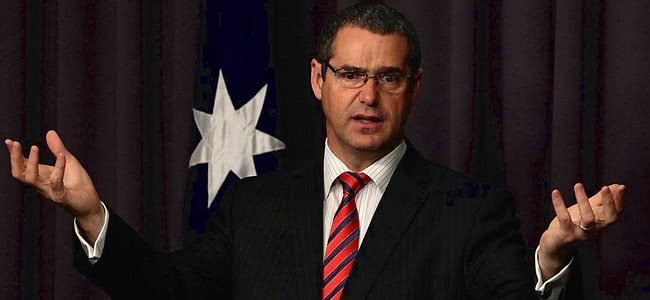“You didn’t have to cut me off!” goes the line from Gotye’s Grammy-winning “Somebody That I Used To Know;“ that sentiment has hardly rung truer than it did yesterday when Wally de Backer released a public letter to Federal Communications Minister Senator Stephen Conroy, urging him to reinstate the funding promised to the community radio sector for their digital programming.
Gotye’s proposal was an extension of the Commit To Community Radio campaign, which has been running intensely since the Federal Government revealed a funding shortfall for community digital radio services of $1.4 million per annum in the 2012 budget.
The fear from the community sector is that as analog radio is phased out permanently, forcing a migration to digital – as is the case with analog TV at the end of 2013 – as many as 37 stations who do not receive the necessary funding may be shut off permanently. The campaign also includes a petition that has been signed by over 40,000 people, including Paul Kelly, Andrew Denton, and The Honourable Michael Kirby, and first attracted over 20,000 signatories over 24 hours during the Commit To Community Radio day of action.
Now as The Music reports, a spokesperson for Minister Stephen Conroy has acknowledged he received the open letter from Gotye, responding tersely, saying he, “appreciated the letter from Mr de Backer and will respond in due course.” In this open reply, Conroy’s representatives also denied that the sector’s funding had been cut and insisted the community sector should pursue “community-sourced revenue” more intently.
In addition to this, the Conroy spokesperson said that, “the facts are that there has been no cut in funding for the community digital radio sector. As part of the 2011-12 Budget the Government provided community radio with an additional $12.5 million over four years – an increase of 25 percent – to boost content and production in the sector.” “The government is proud to augment this funding, but it should never be seen as a substitute for independent community-sourced revenue.” – Spokesperson for Minister Stephen Conroy
It was added that between 2009 and 2013 the Government provided funds to “establish and operate” the sector’s digital services, and that they have also committed to “providing $2.2 million in annual ongoing funding to digital community radio in the forward estimates.” Finally, “the Government has legislated to ensure the community sector can access the radiofrequency spectrum necessary to provide digital radio services,” the spokesperson concluded.
These comments appear in contradiction to the Commit To Community Radio Campaign’s central dictum that arlerts funding was severed as a result of the Government cuts, apparently making it impossible to maintain all of the current community broadcast services. The offical campaign website suggests that if the government does not rectify the shortfall, it could be expected that “all community digital radio services in at least two of the capital cities would have to be shut down.”
However, Conroy’s representative insinuated that regardless of the shortfall, it should not be the Government’s financial burden to fund community radio initiatives but the community’s. “The primary source of funding for community broadcasting, however, has always been and should continue to be drawn from sponsorship and donations from within those communities, independent of government support,” reads the statement.
“The government is proud to augment this funding, but it should never be seen as a substitute for independent community-sourced revenue,” the spokesperson concluded, pointing towards the Government’s rescue of AMRAP through providing funding at the 11th hour.
Inclined to agree with Senator Conroy is Josh Withers, a senior digital producer at Fairfax in Brisbane, who writes in a blog post that while community radio stations provided a “major footstep” into his own career, “public funding for 4CRM, or SYN, or any other community station to establish themselves on digital radio is a waste of taxpayer money.”
Mr Withers’ opinion is that the niche content community radio generally creates and supports is best suited to podcasting, where the production and worker costs are low, and often, at least in Withers’ own case, the number of listers and downloads increased exponentially as a result of moving online. “the facts are that there has been no cut in funding for the community digital radio sector…” – Spokesperson For Minister Stephen Conroy
“Whether the content is niche in a geographic sense, or niche in a taste or culture sense, community radio has been a long time champion of the minorities that Southern Cross Austereo, DMG, ARN and Fairfax have ignored, and going into the ‘digital future’ for those groups that are still calling out for relevant, entertaining, informative content doesn’t need to be on DAB, why not podcast?” he writes.
Community digital radio services were launched nationally in 2011 and there are currently 37 metro-wide digital radio services in Sydney, Melbourne, Brisbane, Adelaide and Perth, but many risk being axed if they don’t receive the financial assistance they so desperately require.
In an effort to highlight what an Australia without digital community radio could sound like, youth community radio station SYN in Melbourne launched their Day of Action yesterday in support of the Commit to Community Radio Campaign, switching off of its digital and FM services at 4pm. This followed 10 hours of campaign specific programming, aiming to highlight the importance of community radio and independent media. The station resumed programming at 12.01am this morning.
Local musician Ella Hooper, former frontwoman of Killing Heidi turned solo artist, was the ironic executioner nominated to switch off SYN’s services, just over 10 years after she switched the station on in 2003. As a further push, SYN volunteers have taken to the streets dressed as dinosaurs to spread the message of community digital funding and deliver a personal letter to Senator Stephen Conroy.
Broadly speaking, the Commit To Community Radio Campaign highlights that around a quarter of Australian radio listeners turn to community radio stations every week for services that include specialist music, Indigenous media, multicultural and ethnic language programs, religious, educational and youth services, print disability reading services, and community access programs.




































